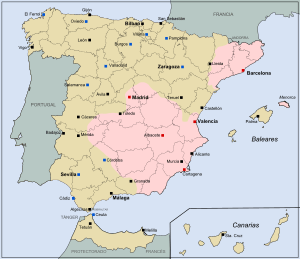Central Region Army Group
The Central Region Army Group, Spanish: Grupo de Ejércitos de la Región Central (GERC), was a military formation of the Spanish Republican Army during the last phase of the Spanish Civil War. It gathered the most powerful section of the republican military and would endure until the 1939 surrender. The GERC was under the command of general José Miaja Menant, the Defence of Madrid hero.
| Central Region Army Group Grupo de Ejércitos de la Región Central (GERC) | |
|---|---|
Military flag of the Popular Army | |
| Active | 22 April 1938 – 29 March 1939 |
| Country | |
| Branch | Spanish Republican Army |
| Type | Army group |
| Role | Home Defence |
| Engagements | |
| Commanders | |
| Notable commanders | General José Miaja Menant |

History
The Central Region Army Group was established on 16 April 1938 by means of an order of the general Staff of the Popular Republican Army. It sought to reorganize the Republican forces following the disastrous campaigns of the Aragon Offensive and the splitting of the Spanish Republican territory in two by the rebel faction. It was initially named "Group of Armies of the Central-Southern Zone" (Agrupación de Ejércitos de la Zona Centro-Sur) before being renamed as Central Region Army Group.[1] At the time of its establishment it was composed by four armies, the Andalusian Army (Ejército de Andalucía), the Extremaduran Army (Ejército de Extremadura), Central Army (Ejército del Centro) and Levantine Army (Ejército de Levante), as well as 16 Army corps, 49 divisions and 138 mixed brigades.[2] It also included a Coastal Defence brigade and the two anti-aircraft artillery brigades of the Defensa Contra Aeronaves (DCA).[3]
In June the same year, the Eastern Region Army Group Grupo de Ejércitos de la Región Oriental (GERO) would be established as well. In December 1938 the GERC was scheduled to take part in General Vicente Rojo Lluch's "Plan P", an ambitious project of an offensive campaign in Extremadura that would have taken place at the same time as a disembarkment within the enemy lines in Motril, along with diversionary attacks in other places of Andalusia and the Madrid Front. However, in the face of the opposition of General Miaja and other Republican commanders to the implementation of the whole plan, it was not carried out to its full extent and the only action taken was the Battle of Valsequillo which resulted in failure shortly before having been initiated.[4]
Following the fall of Catalonia in February, on 2 March 1939 President Juan Negrín arranged for a reorganization of the Republican Armed Forces in the Central Zone, decreeing the disbandment of the GERC, as well as a reorganization of the command structure.[5] However, Segismundo Casado's coup that took place a few days later would hinder the implementation of these eleventh-hour measures.
Structure
| Central Army | |||
| I Army Corps | 1st, 2nd & 69th | Guadarrama - Somosierra | |
| II Army Corps | 4th, 7th & 65th | Las Rozas - Usera - Carabanchel | |
| III Army Corps | 9th, 15th & 18th | Jarama-Aranjuez | |
| IV Army Corps | 12th, 17th & 33rd | Guadalajara - Montes Universales | |
| VI Army Corps | 5th, 10th & 8th | Tajo - Jarama | |
| Fourteenth Guerrilla Army Corps[7] | - | Rear guard | |
| Extremaduran Army | |||
| VII Army Corps | 36th & 37th | Algodor - Zújar | |
| VIII Army Corps | 38th, 63rd & 51st | Zújar - Guadalmellato | |
| Andalusian Army | |||
| IX Army Corps | 20th, 21st & 54th | Córdoba - Jaén | |
| XXIII Army Corps | 23rd & 71st | Granada - Almería | |
| Levantine Army | |||
| XIII Army Corps | 28th & 65th | Montes Universales - Albarracín | |
| XVI Army Corps | 39th & 48th | Levante | |
| XVII Army Corps[8] | 19th, 40th & 25th | Levante | |
| XIX Army Corps | 64th & 66th | Levante | |
| XX Army Corps | 49th & 53rd & C | Levante | |
| XXI Army Corps | 68th, 52nd & 6th | Espadán | |
| XXII Army Corps[8] | 47th, 70th & 41st | Levante | |
See also
- Spanish Civil War, 1938–39
- Final offensive of the Spanish Civil War
- Eastern Region Army Group Grupo de Ejércitos de la Región Oriental (GERO)
References
- Octavio Ruiz Manjón-Cabeza (1990); La Segunda República y la guerra, pág. 588
- Octavio Ruiz Manjón-Cabeza (1990); La Segunda República y la guerra, pág. 598
- J. V. de Leito Aparici (2000); Defensa antiaérea republicana, 1936-1939: artillería y refugios, pág. 89
- Hugh Thomas (1976); La Guerra Civil Española, pp. 932-935
- Ángel Bahamonde Magro et al (2000); Así terminó la Guerra de España, pág. 341
- Carlos Engel, p.253
- Michael Alpert, p. 391
- Antony Beevor, p.486
Bibliography
- Alpert, Michael (1989); El Ejército Republicano en la Guerra Civil, Siglo XXI de España, Madrid.ISBN 978-84-323-0682-2
- Engel Masoliver, Carlos (1999); Historia de las Brigadas mixtas del Ejército popular de la República, 1936-1939, Editorial Almena, Madrid, 1999 ISBN 84-96170-19-5.
- Helen Graham (2003). The Spanish Republic at War 1936-1939. Cambridge University Press. ISBN 978-0521459327.
- Salas Larrazábal, Ramón (2006); Historia del Ejército Popular de la República. La Esfera de los Libros S.L. ISBN 84-9734-465-0
- Thomas, Hugh (1976); Historia de la Guerra Civil Española. Círculo de Lectores, Barcelona.ISBN 84-226-0874-X.